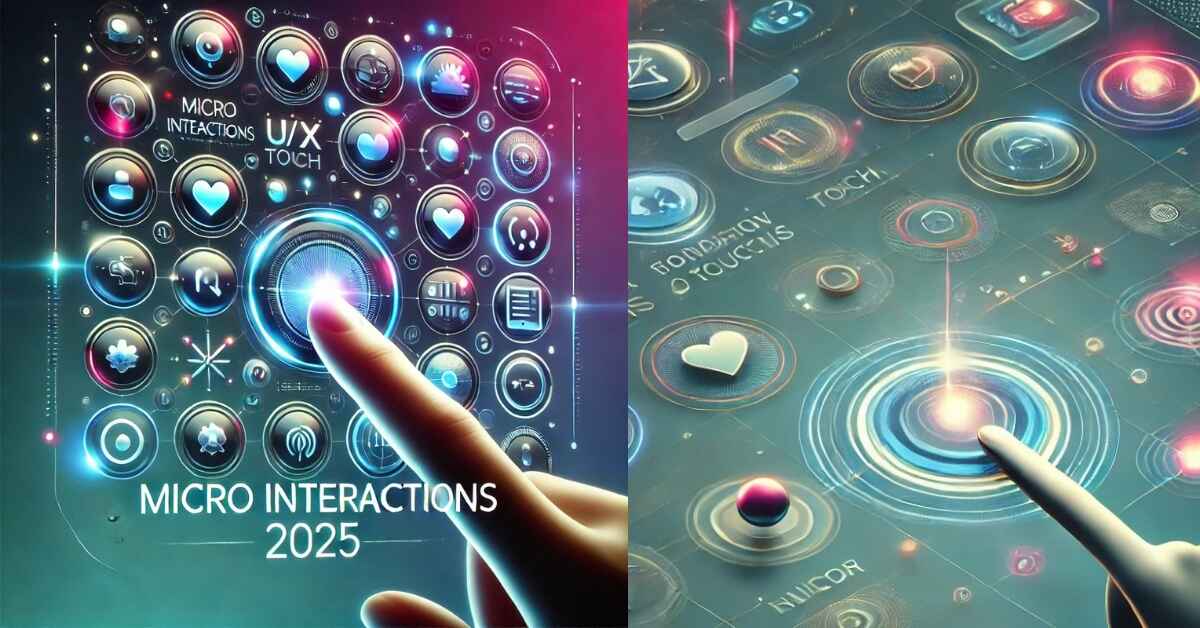Micro interactions 2025 are transforming UI design, providing seamless user experiences and setting new standards in consumer engagement and satisfaction.
Introduction
In the arena of digital studies, “Micro interactions 2025” have become a game-changer. As customers demand more intuitive and attractive interactions, micro interactions are reshaping the manner we method consumer interface (UI) design and redefining the consumer revel in (UX).
In easy terms, micro interactions consult with the small, frequently diffused moments inside an app or website that upload pride, offer remarks, or make the revel in feel smoother and more human. With 2025 at the horizon, these tiny but powerful interactions are set to play a pivotal position in remodeling how users interact with era on a every day foundation.
What Are Micro Interactions?
At their middle, micro interactions are unmarried, non permanent actions or responses within an interface that serve a particular feature. Examples encompass the gentle vibration while you press a button on your phone, the diffused animation of a loading display screen, or even the visible comments you get hold of whilst clicking a ‘like’ button.
These information may also seem minor, but they upload up to create a extra immersive and attractive enjoy. In 2025, micro interactions are taking on even extra significance as they end up a using force in making generation experience extra intuitive and private.
The Rise of Micro Interactions in 2025
The attention on person-centric layout has pushed micro interactions to the forefront of UI and UX design. As we enter 2025, numerous traits and technological improvements are shaping the way we think about and put in force micro interactions. Let’s examine a number of the most vast developments:
Enhanced Personalization and Contextual Awareness
One of the biggest trends in micro interactions 2025 is increased personalization. As devices and applications become more sophisticated, they are gathering more data about users’ behaviors and preferences. This allows designers to create micro interactions that are specifically tailored to each individual. For instance:
- Predictive Typing and Suggestions: Apps can anticipate what users are likely to type or search for based on past behavior, offering relevant suggestions that improve usability and save time.
- Location-Based Interactions: Apps that recognize a user’s location can adapt interactions to provide relevant information. Imagine a travel app that shows weather updates when it detects you’re in a new city.
In 2025, the ability to tailor interactions on a personal level will redefine how people connect with technology, making each experience feel unique and considerate of user needs.
Voice-Activated and Gesture-Based Interactions
As more people interact with devices hands-free, voice and gesture commands are becoming key to creating seamless experiences. Micro interactions within these interfaces offer feedback that ensures the user knows their command was understood. For example:
- Voice Feedback: When users give a voice command, a small sound or haptic feedback can indicate that the command was successfully recognized.
- Gesture Feedback: Swiping or shaking a device to trigger actions is becoming more common. In 2025, gesture-based micro interactions will offer subtle feedback, like screen animations or vibrations, to confirm actions.
These developments make interactions feel intuitive and encourage users to explore new ways of engaging with technology.
Micro Interactions in Augmented Reality (AR) and Virtual Reality (VR)
As AR and VR grow more popular, micro interactions are playing a crucial role in creating believable and immersive environments. In AR and VR applications, where sensory feedback is limited, small visual or auditory cues can bridge the gap and improve user engagement.
- Visual Cues in Virtual Spaces: Imagine using a VR app where subtle animations guide you towards interactive elements, making navigation easier.
- Audio Feedback for Immersion: In an AR game, sound effects when you complete a task or find a hidden object can make the experience feel more realistic.
As VR and AR headsets become more accessible, these micro interactions will be essential for creating smooth and engaging user journeys.
AI-Driven Micro Interactions
Artificial Intelligence (AI) plays a major role in advancing micro interactions 2025. By understanding user behavior patterns, AI can make micro interactions smarter and more effective. Examples include:
- Adaptive Responses: Based on user data, an AI-powered app can change its response over time, offering better solutions and becoming more in tune with what each user needs.
- Enhanced Error Feedback: Instead of a generic error message, an app might provide tailored solutions based on what the AI knows about the user’s activity or previous interactions.
By making these interactions smarter and more adaptable, AI helps create a more satisfying and personalized user experience.
Benefits of Micro Interactions 2025 in UI/UX Design
Micro interactions are proving to be an invaluable tool in modern UI/UX design. Here are some of the major benefits they offer:
Improved User Engagement
Micro interactions add a level of interest and engagement that encourages users to spend more time on an app or website. This improved engagement not only enhances user satisfaction but can also lead to better customer retention.
Better Usability and Guidance
For new users, micro interactions provide subtle guidance on how to navigate and use different features. A small animation or hint can direct users to the right action, reducing frustration and making the interface feel more user-friendly.
Enhanced Emotional Connection
Micro interactions can also create a sense of delight or even humor, making an app feel more human. For instance, a “loading” animation that includes a fun message or image can bring a smile to the user’s face, turning what could be a frustrating wait into a positive moment.
How to Implement Effective Micro Interactions
To maximize the potential of micro interactions 2025, it’s essential to use them thoughtfully. Here are some best practices to follow:
Keep It Simple
Micro interactions should enhance, not overwhelm. They should be subtle enough that they blend naturally into the experience. For example, a button press should trigger a small animation but not something that distracts from the user’s main goal.
Ensure Consistency
Micro interactions should be consistent with the brand’s voice and design language. For instance, if a brand uses soft colors and gentle animations, the interactions should reflect that style to maintain coherence.
Provide Feedback Without Interrupting Flow
Feedback is a important a part of micro interactions, however it need to now not interrupt the user’s waft. Instead of the use of a pop-up message, recall a small animation or colour change to signal that an movement turned into successful.
Also read: Design Technologies Drone.
Future of Micro Interactions: What to Expect Beyond 2025
Looking past 2025, the destiny of micro interactions guarantees even greater modern and seamless reports. As technology like AI, machine learning, and augmented reality maintain to increase, we may additionally see the subsequent traits emerge:
Context-Aware Micro Interactions
In the future, apps and gadgets may be capable of detect the consumer’s emotional kingdom or environment and regulate micro interactions thus. Imagine a shopping app that suggests one of a kind prompts or comments based on whether the consumer is in a quiet or busy place.
Haptic Feedback on Wearables
With the upward thrust of wearable era, haptic remarks will play an more and more important role. Smart watches, as an example, might use particular vibration patterns to sign exclusive kinds of notifications, making it easier for customers to apprehend indicators at a glance.
More Inclusive Design Through Accessibility
Micro interactions can also contribute to making virtual products more handy. By adding visual or auditory cues, designers can help customers with disabilities navigate interfaces more effortlessly, making sure that technology is inclusive and usable for anyone.
Conclusion
Micro interactions 2025 are not only a passing fashion; they are fundamentally converting the way users revel in and have interaction with era. By that specialize in diffused, purposeful design elements, micro interactions create a greater personalised, enticing, and efficient user adventure.
As technology maintains to evolve, micro interactions will play an essential position in bridging the gap among human beings and machines, reworking digital interfaces into seamless, intuitive areas in which users experience understood and supported. For any designer or brand aiming to live applicable, embracing the electricity of micro interactions is fundamental to handing over a memorable, person-targeted revel in.





































